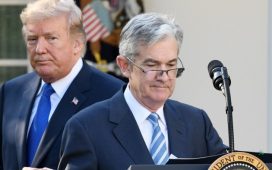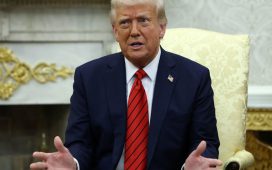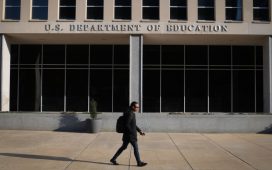This article is an on-site version of our Unhedged newsletter. Sign up here to get the newsletter sent straight to your inbox every weekday
Good morning. We told you we would keep an eye on Walmart’s earnings. There was plenty to see. Executives warned about recent weakness in consumer spending, and the retailer’s shares fell 8 per cent yesterday. We remain stubbornly optimistic about the likelihood of a soft landing, but the Walmart wobble is a reminder that the post-pandemic balancing act is very delicate. Email us: robert.armstrong@ft.com and ethan.wu@ft.com.
Unhedged talks to Olivier Blanchard
If years of dire predictions have dulled your sense of urgency about budget deficits, we sympathise. In a low-rates world, deficit hawks could be safely ignored.
The low-rate world looks increasingly far away, though. In its place we have rallying long-term yields, massive deficits and rising interest burdens. The most important fiscal relationship, the gap between real rates and long-term growth (“r minus g”), has gone from negative to near-zero.
Olivier Blanchard, MIT professor, IMF chief economist during the global financial crisis, and now fellow at the Peterson Institute, is worried about where the fiscal story ends. In a blog post this month, he lays out the ultra-narrow path governments must walk: reducing fiscal burdens slowly enough to avoid killing demand, but quickly enough to soothe bond investors, all while investing in military readiness and climate mitigation. In a recent conversation, Unhedged quizzed Blanchard on inflation, why long yields are rising, and the fiscal endgame.
The interview below has been edited for clarity and concision.
Unhedged: You make a distinction in your blog post between high debt ratios, which are somewhat inevitable given our political situation, and a debt explosion. How do we know when we have crossed that line? And what are the consequences of an explosion?
Olivier Blanchard: That’s indeed the issue. Visually, one is a convex curve, which explodes, and one is a concave curve, which converges to some level. In real time, how do you decide which one you face? I think you decide based on what the government seems to be willing to do in terms of the sequence of primary deficits.
The simple case is where r minus g is zero, roughly where we are today. Then you just ask: is there a plan to actually get primary deficits to zero in some finite time, in a credible way? Is it all smoke and mirrors, or real measures? If [governments] use a growth rate which is not realistic, if they use an interest rate which is lower than the market rate, then you know they’re not serious. There have to be measures which do the job. That’s how you decide when one is okay and the other is not.
Unhedged: How reassured should we be if inflation continues to come back towards the 2 per cent target?
Blanchard: I think it depends on where you look on the yield curve. Clearly, the news [in this week’s October CPI report] was good. Maybe the Fed doesn’t have to increase interest rates; maybe it can decrease them faster. But I think what we’ve seen, and what led me to write the blog, is that it should not have much effect on the five-year/five-year rate [ie, where markets expect the five year rate to be five years from now]. Looking five or 10 years out, how long it will take for the Fed to succeed in the fight against inflation shouldn’t be relevant.
So what has happened is the five-year/five-year and other rates which are beyond the effects of short-run monetary policy have gone up. That’s the worrisome part. And it’s not clear that the news on CPI has much to do with that.
Unhedged: And why are long rates rising?
Blanchard: That’s the trillion-dollar question. There are a number of possible factors. The first thing is policy being tighter for longer. As I just said, I don’t believe that that’s relevant five years out. So we’ll leave this aside. Second is a higher than expected inflation rate into the distant future. The break-even rates [ie, market pricing of future inflation] suggest that long-run inflation expectations really have not moved much, so this can be left aside as well. Third, markets could be pricing in a credit spread on long Treasuries [suggesting US sovereign bonds carry some default risk]. I do not think this is the case. Maybe investors should ask for a spread, but I don’t think they do today.
Then there’s the notion that maybe we’re going to have stronger private demand. It could be due to consumers consuming more; I’m sceptical, because I think they are consuming more because they have higher savings, and this will go away. But it’s conceivable that we’re going to be serious about green investment. And that could increase the investment rate by, say, 1 per cent of world GDP. This could do something to the long rate, but I think that, for the time being, it’s a marginal effect.
The next one is higher potential growth — that a higher r comes with a higher g. Maybe artificial intelligence is going to create an enormous productivity boom. It’s not crazy . . . 1 per cent a year more is not inconceivable. This would explain why long rates have gone up. If this is the case, then the increase in r is not such bad news, as it comes with an increase in g.
Finally, we get to the factor which is probably most relevant, which is what finance people call the term premium. You can think of it in two ways. The first one is in terms of [Treasury bond] flow supply and flow demand. At this stage, there is a lot of supply and for various reasons there is less demand. There is QT [quantitative tightening], which is increasing supply from the Fed. It’s conceivable that that’s part of it. And the fact that long rates vary so much on news about the US Treasury changing the maturity of its issuance makes me think that it is probably relevant. It may not last.
The second one is to think of the term premium as a risk premium. One hypothesis is that we may be worrying more about the variance of inflation. I don’t think that’s it, because in that case we would see the nominal rates go up, but not rates on inflation-indexed bonds. But these rates have gone up as well. So this leaves uncertainty about real rates — with uncertainty about future real rates leading to higher long real rates today. This is not a crazy hypothesis. There are many reasons to think that there’s more uncertainty.
Of all these factors, flow supply/flow demand would be first on my list. Uncertainty about real rates might be next. And then the others marginally so. Then you have to decide, okay, so is the increase going to be transitory or permanent? My own guess is a good part of this will go away. But not all of it . . . so the message of my blog was, please have plans for a steady reduction of primary deficits to close to zero. Slow, steady, convincing, credible.
Unhedged: What would be the economic consequences if, in the US, debt ratios did explode? How should central bankers respond? Will there be a temptation to monetise the debt?
Blanchard: My sense is investors are not yet worried about being repaid if they hold Treasury bonds. For something to happen, it’s going to have to be more and more evident that nothing is being done. And then what happens? As hard as it is to imagine, there might be an emerging credit spread on T-bonds or a failed auction. And then Congress and the president would have to sit down and decide to do the right thing.
A scary alternative scenario is that Donald Trump is elected, that he puts a lackey at the Fed, who monetises some of the debt, and we get high inflation. We know that high unexpected inflation does great things for the debt ratio.
My sense is it’s going to boil slowly. I don’t know how it ends; not smoothly, is my guess. There is a happier outcome in which somehow the president and Congress get scared early enough to actually be willing to act, taking up entitlements and so on. Let’s hope it happens.
One good read
Our heads hurt from trying to make sense of this story about private credit.
FT Unhedged podcast

Can’t get enough of Unhedged? Listen to our new podcast, hosted by Ethan Wu and Katie Martin, for a 15-minute dive into the latest markets news and financial headlines, twice a week. Catch up on past editions of the newsletter here.







